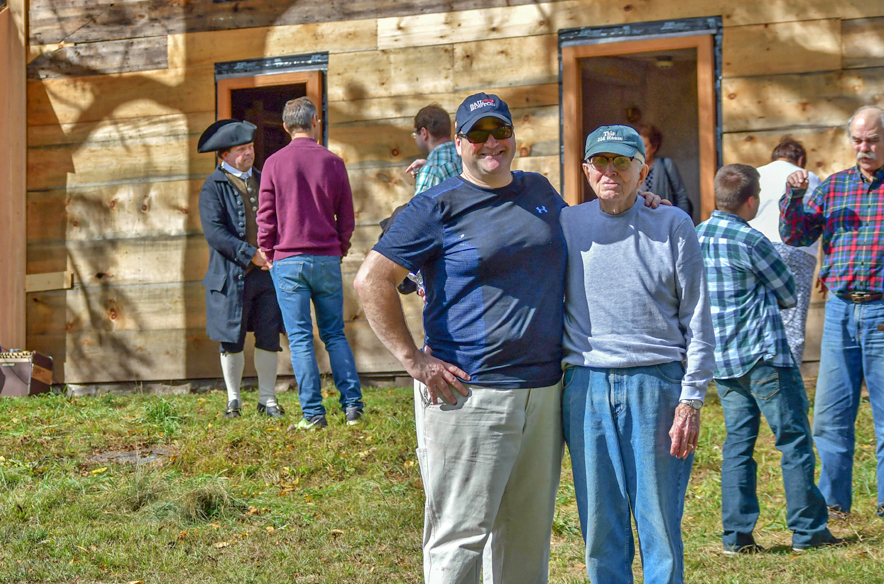Remembering Wally: Rest in Peace, Dear Friend
By George T. Comeau
Longtime friends and collaborators George Comeau and Wally Gibbs celebrate the fruits of their labor during a ‘Colonial Days’ event at the David & Abigail Tilden House in the fall of 2019. (Cynthia Rosina photo)
The full version of this story appears in the November 23 print edition of the Canton Citizen.
The message was not unexpected. It was a text that read, simply, “George, call me. This is Wally Gibbs’ daughter.”
I knew a text at 6:15 on a Sunday morning was not the harbinger of good news. And I knew deep down what this call was about. “Wally fell down and fractured his hip …” The rest was a blur, something about internal bleeding, resting comfortably, you may want to visit your friend for the last time. And, within hours, Wally had left us at age 89.
It was not unexpected from anyone who knew Wally. The beauty of this man’s life was his commitment to Marie, his wife of over 67 years. There was no sentence concerning either of them that did not contain the words “Wally and Marie.” They had a beautiful relationship and suffered the sadness of loss bravely together. When their son Mark died, it was a burden that Wally carried deeply in his soul. Years later, their daughter-in-law Sue passed away, and the melancholy fell over both Wally and Marie. But together they grew old in a house that was a mirror of their lives.
Wally was a man of many talents, and foremost was his love of history. Moving to Canton in the mid 1950s, he lived with his family in a small house on York Street. At the time, York Street was not the fashionable address that it conveys today. It was a simple, winding and rural county road. The folk who lived there were hardy, resilient and depended upon each other when winter storms would close down any connection to Randolph Street. It was a neighborhood like any other, and the Gibbs were part of the glue of the community.
Wally worked for the telephone company and was quite good at his job. Together with Marie, he raised four amazing children, Mark, Christopher, Sue and Amy, each heeding the call to serve their community in their own way.
With an early foray into historic preservation, Wally was influenced by the controversy surrounding the rezoning and subsequent development of the historic Prowse Farm property. The early fight for the history of the town was bloody and ended in a defeat and a consent decree from the courts. For many, the loss of the historic buildings in the face of corporate expansion onto sacred land was a turning point. Some folks turned away altogether, and others were emboldened to fight again. Suffice to say, the passion for history was deeply rooted in Wally.
As he and Marie became empty nesters, they set out to build a house on the tract of land they owned behind their house. Marie was an artisan and had been heavily involved in the Canton Garden Club. The new house needed to suit her love of art, textiles and crafts and be a gathering place for the family. Wally, a craftsman himself, wanted to build a replica of an early American colonial home, with some updates for the way we live in a modern era. And that is what they did together.
The General Sylvanus Thayer House, perhaps the most historic saltbox in Braintree, was the model that Wally chose. Countless visits yielded detailed drawings, which ultimately became the house on York Street. The house is a work of art in both form and detail. Wally made all of the interior cabinetry and woodworking. Marie filled the house with her crafts, and the smell of stew was always in the air as the cats slept lazily in handmade wicker baskets. And yet there were modern details that the Gibbs turned away from. Central air, a dishwasher and other conveniences were not in the minds of these generous, yet frugal New Englanders.
There was no word such as “retirement” in Wally’s lexicon. Instead, the days were filled with work, advocacy, and a love for Canton. I cannot recall when Wally and I first met, but it must have been during one of my races for the Planning Board in my early 20s. My wife reminds me that Wally and Marie hosted a neighborhood meet and greet at their home for me. Dozens of people came, more to see the house than see me, I am quite sure. But whatever brought us together, history cemented the bond.
Wally became the chairman of the Canton Historical Commission and the president of the Historical Society. While known affectionately to locals as the “Histy,” Wally called it the “Histry” — a sign of a carpetbagger. But since Canton was once Dorchester in the early 17th century, Wally claimed he had never left the town of his birth.
We preserved a lot of things in our days together. We wrote the Scenic Road Bylaw and created the National Historic District at Canton Corner. We fought for money to clean gravestones, and we mourned the loss of historic sites to demolition …
See this week’s Canton Citizen to read the full version of this story. Click here to order your subscription today (also available in digital form).
Short URL: https://www.thecantoncitizen.com/?p=95952










